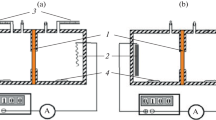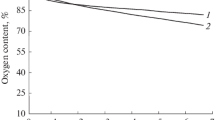Abstract
The concentration dependence of the sulfate and the phosphate selfexchange and homoexchange fluxes was studied in resealed red cell ghosts (25° C, pH 7.3). The selfexchange fluxes were calculated from the rate constant of the tracer back-exchange and from the intracellular substrate anion content. The homoexchange fluxes were determined from the initial cis-to-trans tracer fluxes and the initial specific substrate anion activities at the cis-membrane side. Sulfate and phosphate concentrations ranging from approx. 2–100 mM were employed.
The selfexchange fluxes of sulfate and of phosphate exhibit sigmoidal flux/concentration curves. The apparent Hill coefficients were in the range of 1.2–1.4 indicating a type of positive cooperativity. Under homoexchange conditions the positive cooperativity of the flux/concentration curves disappears. The outward homoexchange fluxes of sulfate and phosphate display a saturation kinetics with Hill coefficients close to 1.0. The inward homoexchange fluxes exhibit a negative type of cooperativity with Hill coefficients smaller than 1.0. The sulfate and the phosphate half-saturation concentrations for the outer and the inner membrane surface are equal in size and amount to approx. 35 mM for sulfate and to approx. 110 mM for phosphate, respectively.
The positive cooperativity of the unidirectional sulfate and phosphate fluxes under selfexchange conditions and the disappearance of the positive cooperativity under homoexchange conditions indicate a cooperativity of the translocation process. The saturation of the outward homoexchange flux and the negative cooperativity of the inward homoexchange flux suggest a substrate anion binding according to the law of mass action at the inner and a negative cooperativity of substrate anion binding at the outer membrane surface.
Similar content being viewed by others
References
Bodemann H, Passow H (1972) Factors controlling the resealing of the membrane of human erythrocyte ghosts after hypotonic hemolysis. J Membrane Biol 8:1–26
Brahm J (1977) Temperature-dependent changes of chloride transport kinetics in human red cells. J Gen Physiol 70:283–306
Cabantchik ZI, Rothstein A (1972) The nature of the membrane sites controlling anion permeability of the human red blood cell as determined by studies with disulforniscstilbene derivatives. J Membrane Biol 10:311–330
Cabantchik ZI, Rothstein A (1974) Membrane proteins related to anion permeability of human red blood cells. I. Localization of disulfonicstilbene binding sites in proteins involved in permeation. J Membrane Biol 15:207–226
Cabantchik ZI, Wolosin JM, Ginsburg H, Zedel O (1977) Structural and functional properties of the anion transport system isolated from human erythrocyte membranes. In: Semenza G, Carafoli E (eds) Biochemistry of membrane transport, Springer, Berlin Heidelberg New York, pp 328–345
Cabantchik ZI, Volsky DJ, Ginsburg H, Loyter A (1980) Reconstitution of the erythrocyte anion transport-system: in vitro and in vivo approaches. Ann NY Acad Sci 341:444–454
Dalmark M (1975) Chloride transport in human red cells. J Physiol (Lond) 250:39–64
Dalmark M (1976) Effects of halides and bicarbonate on chloride transport in human red blood cells. J Gen Physiol 67:223
Dalmark M (1976) Chloride in the human erythrocyte: distribution and transport between cellular and extracellular fluids and structural features of the cell membrane. Prog Biophys Mol Biol 31:145–164
Deuticke B (1977) Properties and structural basis of simple diffusion pathways in the erythrocyte membrane. Rev Physiol Biochem Pharmacol 78:1–95
Fröhlich O, Leibson C, Gunn RB (1983) Chloride net efflux from intact erythrocytes under slippage conditions: Evidence for a positive charge on the anion binding/transport site. J Gen Physiol 81:127–152
Funder J, Wieth JO (1976) Chloride transport in human erythrocytes and ghosts: a quantitative comparison. J Physiol (Lond) 2621:679–698
Gardos G, Hoffmann JF, Passow H (1969) Flux measurements in erythrocytes. In: Passow H, Stämpfli R (eds) Laboratory techniques in membrane biophysics. Springer, Berlin Heidelberg New York, pp 9–20
Gunn RB (1973) A titrable carrier for monovalent and divalent inorganic anions in red blood cells. In: Lerach E, Moser K, Deutsche E, Wilmans W (eds) Erythrocytes, thrombocytes, leukocytes. Thieme, Stuttgart, pp 77–74
Gunn RB (1978) Consideration of the titrable carrier model for the sulfate transport in human red blood cells. In: Hoffman JF (ed) Membrane transport processes, vol 1. Plenum Press, New York, pp 66–77
Gunn RB, Dalmark M, Tosteson DC, Wieth JO (1973) Characteristics of chloride transport in human red blood cells. J Gen Physiol 61:185–206
Gunn RB, Fröhlich O (1979) Asymmetry in the mechanism for anion exchange in human red blood cell membranes: Evidence for reciprocative sites that react with one transported anion at a time. J Gen Physiol 74:351–374
Heinz E (1978) Mechanics and energetics of biological transport. Springer, Berlin Heidelberg New York
Jennings ML (1980) Apparent “recruitment” of SO4 transport sites by the Cl gradient across the human erythrocyte membrane. In: Lassen U, Ussing H, Wieth JO (eds) Membrane transport in erythrocytes. Munksgaard. Copenhagen, pp 450–463
Knauf P (1979) Erythrocyte anion exchange and the band 3 protein: transport kinetics and molecular structure. Current Topics in Membranes and Transport, 12:251–363
Knauf PA (1982) Kinetic asymmetry of the red cell anion exchange system. In: Martonosi AN (ed) Membranes and Transport. Plenum Press, New York, pp 441–449
Knauf PA, Fuhrmann GF, Rothstein S, Rothstein A (1977) The relationship between anion exchange and net anion flow across the human red blood cell membrane. J Gen Physiol 69:363–386
Knauf PA, Tarshis T, Grinstein S, Furuya W (1980) Spontaneous and induced asymmetry of the human erythrocyte anion exchange system as detected by chemical probes. In: Lassen U, Ussing H, Wieth JO (eds) Membrane transport in erythrocytes. Munksgaard, Copenhagen, pp 389–403
Knauf PA, Law FY, Marchant PJ (1983) Relationship of net chloride flow across the human erythrocyte membrane to the anion exchange mechanism. J Gen Physiol 81:95–126
Köhne W, Haest CWM, Deuticke B (1981) Mediated transport of anions in band 3-phospholipid vesicles. Biochim Biophys Acta 664:108–120
Kotyk A, Janáček K (1970) Cell membrane transport: Principles and techniques. Plenum Press, New York London
Lepke S, Passow H (1972) The effect of pH at hemolysis on the reconstitution of low cation permeability in human erythrocyte ghosts. Biochim Biophys Acta 255:696–702
Lepke S, Fasold H, Pring M, Passow H (1976) A study of the relationship between the inhibition of anion exchange and binding to the red blood cell membrane of 4,4′-diisothiocyanostilbene-2,2′-disulfonic acid (DIDS) and its dihydroderivative (H2DIDS). J Membrane Biol 29:147–177
Macara IG, Cantley LC (1983) The structure and function of band 3. In: Elson E, Frazier W, Glaser L (eds) Cell membranes: methods and reviews, vol 1, Plenum Press, New York pp 41–87
Milanick HA, Gunn RB (1982) Proton-sulfate Co- Transport, mechanism of H+ and sulfate addition to the chloride transporter of human red blood cells. J Gen Physiol 74:87–113
Passow H (1982) Anion-transport-related conformational changes of the band 3 protein in the red blood cell membrane. In: Martonosi AN (ed) Membranes and transport, vol. 2, Plenum Press, New York London pp 451–460
Ross AH, Connell RHM (1978) Reconstitution of the erythrocyte anion channel. J Biol Chem 253:4777–4782
Rothstein A (1982) Functional structure of band 3, the anion transport protein of the red blood cell, as determined by proteolytic and chemical cleavages. In: Martonosi AN (ed) Membranes and transport, vol 2. Plenum Press, New York, pp 435–440
Rothstein A, Cabantchik ZI, Balshin M, Juliano R (1975) Enhancement of anion permeability in lecithin vesicles by hydrophobic proteins extracted from red blood cell membranes. Biochem Biophys Res Commun 64:144–150
Schnell KF (1977) Anion transport across the red cell membranes mediated by dielectric pores. J Membr Biol 37:99–136
Schnell KF (1979) The anion transport system of the red blood cell. In: Kuczera J, Gabrielska J, Przestalski S (eds) Biophysics of membrane transport Wrosŀaw 1979, Pulishing Dep Agricultural University of Wrosŀaw, pp 216–252
Schnell KF, Gerhardt S (1973) The effect of the membrane potential on the anion exchange across the erythrocyte membrane. Pflügers Arch 343:R60
Schnell KF, Gerhardt S, Schöppe-Fredenberg A (1977) Kinetics characteristics of the sulfate self-exchange in human red blood cells and red blood cell ghosts. J Membr Biol 301:319–350
Schnell KF, Besl E, Manz A (1978) Asymmetry of the chloride transport system in human erythrocyte ghosts. Pflügers Arch 375:87–95
Schnell KF, Besl E, Kolb G (1980) The concentration response of the unidirectional sulfate and phosphate flux in red cell ghosts. Pflügers Arch 384:50
Schnell KF, Besl E, Mosel R von der (1981) Phosphate transport in human red blood cells: concentration dependence and pH-dependence of the unidirectional phosphate flux at equilibrium conditions. J Membr Biol 61:173–192
Segel IH (1975) Enzyme kinetics, behavior and analysis of rapid equilibrium and steady-state enzyme systems. John Wiley and Sons, New York London Sidney Toronto
Ship S, Shami Y, Breuer W, Rothstein A (1977) Synthesis of tritiated 4,4′-diisothiocyano-2,2′-stilbene disulfonic acid (H2-DIDS) and its covalent reaction with sites related to anion transport in red blood cells. J Membr Biol 33:311–324
Steck TL (1978) The band 3 protein of the human red cell membrane: A review. J Supramol Struct 8:311–324
Webb JL (1963) Enzyme and metabolic inhibitors. Academic Press, New York London
Wieth JO, Dalmark M, Gunn RB, Tosteston DC (1973) The transfer of monovalent inorganic anions through the red cell membrane. In: Gerlach E, Moser K, Deutsch E, Wilmans W (eds) Erythrocytes, thrommbocytes, leukocytes. Thieme, Stuttgart pp 71–76
Wieth JO, Bjerrum PJ, Brahm J, Andersen OS (1982) The anion transport protein of the red cell membrane, a zipper mechanism of anion exchange. Tokai J Exp Clin Med 7:91–101
Wolosin JM (1980) A procedure of membrane-protein reconstitution on the functional reconstitution of the anion transport system of the human erythrocyte membrane. Biochim J 189:35–44
Wolosin JM, Ginsburg H, Cabantchik ZI (1977) Functional characterization of anion transport system isolated from human erythrocyte membranes. J Biol Chem 252:2419–2427
Wood PG, Passow H (1981) Techniques for the modification of the intracellular composition of red blood cells. In: Techniques in cellular physiology. Elsevier/North-Holland Scientific Publishers Ltd., Amsterdam, p 112
Zaki L, Fasold H, Schuhmann B, Passow H (1975) Chemical modification of membrane proteins in relation to the inhibition of anion exchange in human red blood cells. J Cell Physiol 86:471–494
Author information
Authors and Affiliations
Rights and permissions
About this article
Cite this article
Schnell, K.F., Besl, E. Concentration dependence of the unidirectional sulfate and phosphate flux in human red cell ghosts under selfexchange and under homoexchange conditions. Pflugers Arch. 402, 197–206 (1984). https://doi.org/10.1007/BF00583335
Received:
Accepted:
Issue Date:
DOI: https://doi.org/10.1007/BF00583335




